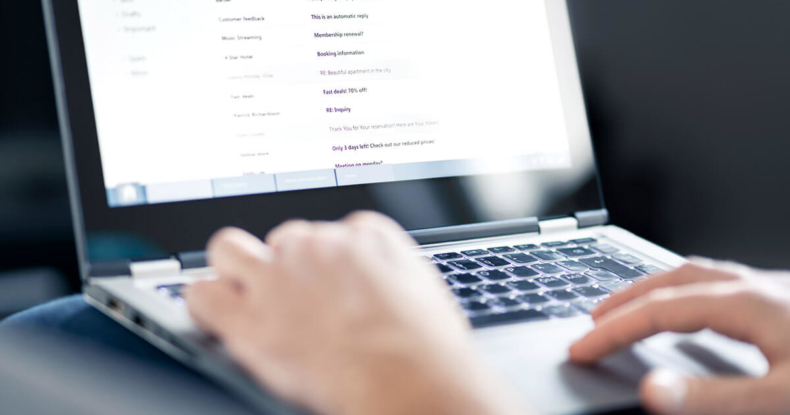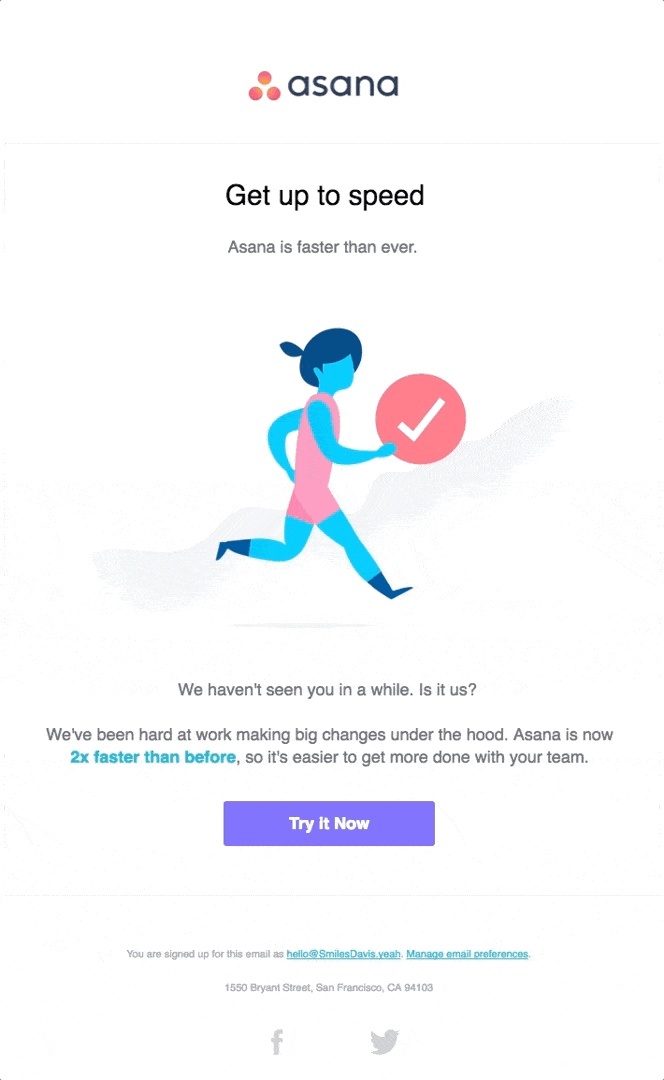Many believe that email as a marketing channel has an expiration date. But time and again, the potency of email marketing has proved this wrong. Not only has it remained a steady lead conversion method, but it has also grown in popularity.
With the number of email users soon to cross over 4 billion worldwide, email marketing is here to stay. If you are not yet reaching out to your customers through this channel, it’s time to begin.
We understand that crafting the perfect email message can be tricky. In this post, we offer you a toolkit of templates to get you started.
11 Email Templates to Get You Started
Inspire your next email marketing campaign with the help of these 11 easy-to-use templates.
1. Introduction/ Welcome Email to Prospects
There are very few things as critical as an introductory email. After all, a welcome email offers first impressions and sets the tone of your relationship with the prospect. So, get your top execs and content people together and brainstorm the perfect introduction email.
For starters, you can check out this example given below.
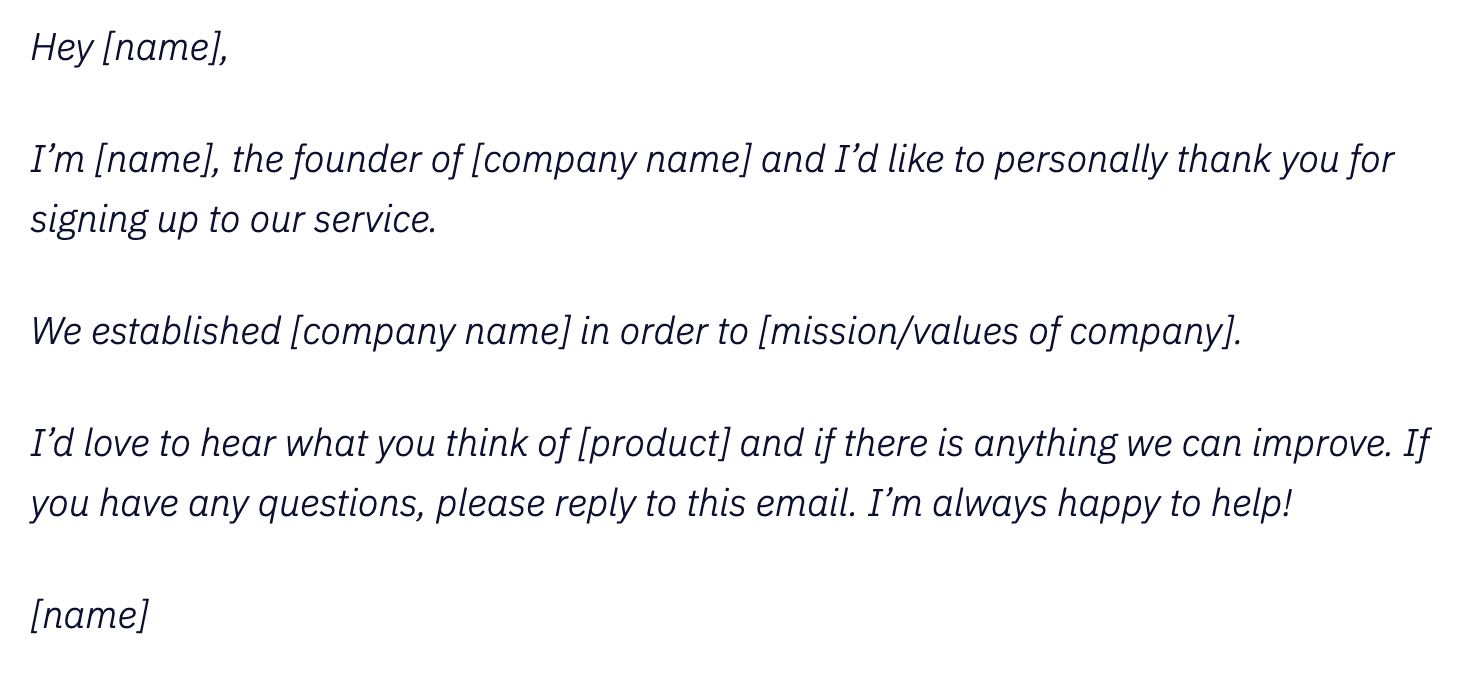
Image Source: Nutshell
Check out this template’s warm yet no-nonsense approach. The template begins by being thankful, then lets the reader know about the product, and closes by asking what they think about it.
Why does it work?
- This template does not beat around the bush.
- The font type and size is clear.
- It is not heavy on content.
Further, it will bode well if you provide the welcome template with a CTA where the prospect can request for a call back. Doing this hints that your company is capable of providing exceptional customer service.
1a. Follow Up Email
Just because a potential customer has not replied to your introductory email doesn’t mean they are not interested. They could have been busy or away on travel. The point is, you should always check-in with prospects you haven’t heard from. You can do this by keeping a follow-up mail ready.
Now, sending a host of clients a follow-up email manually might waste a lot of time and resources. Here you can use email marketing software to automate follow-up emails. A follow-up mail should ideally be sent within the next two days.
Remember, a follow-up mail is critical, and businesses can see a 30% to 40% open rate with this email.
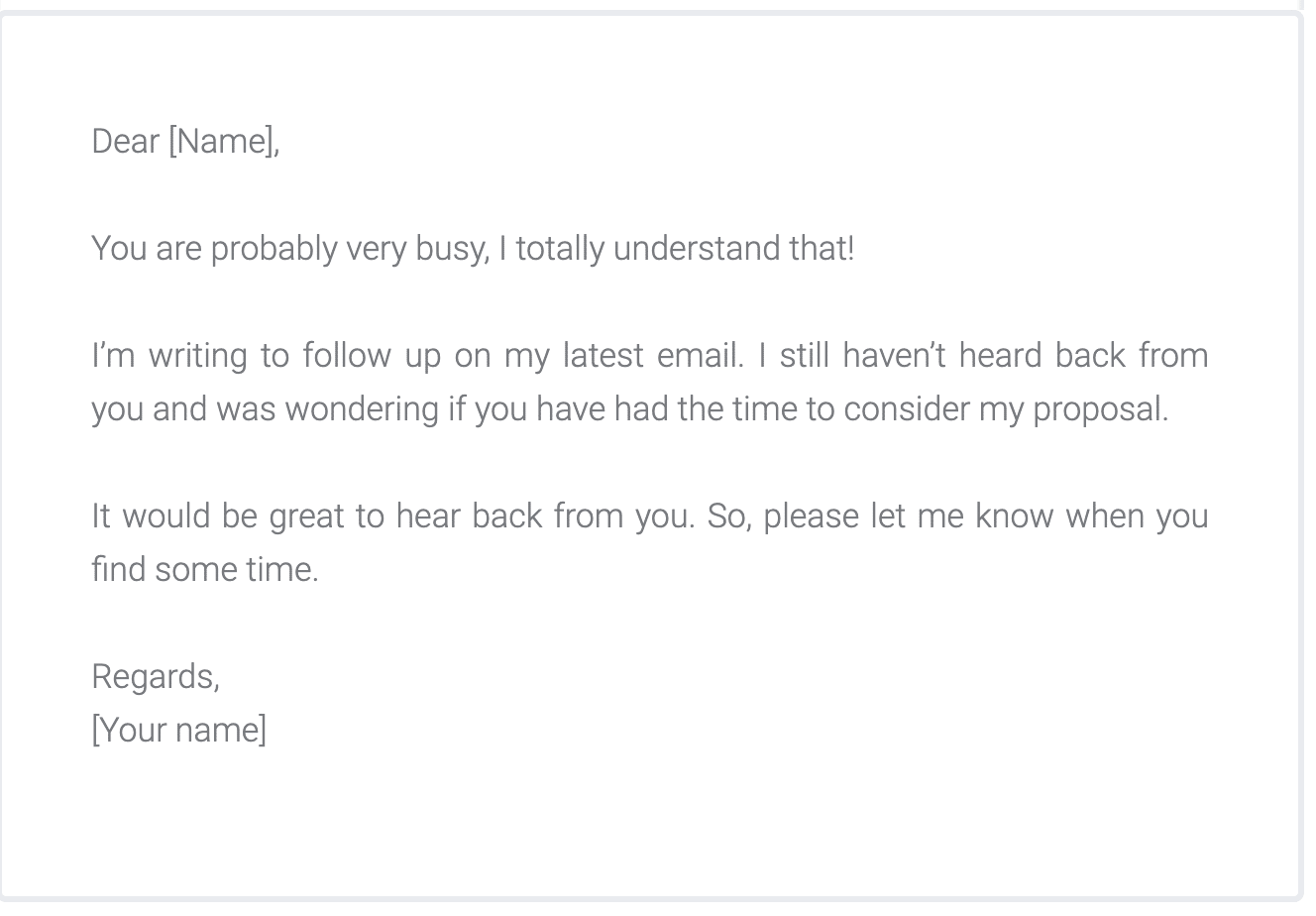
Image Source: Mailigen
Check out the tone of this sample email. It is informative, yet informal.
Why does it work?
- The content is easy to read through.
- It creates a sense of urgency.
- It offers an opening to mention your proposal for a second time.
2. Promotional Email
Think of a promotional email as a digital elevator pitch.
Start by addressing a specific problem that you know the client is facing. Tell them how your product can help and bring in stories of customers who have benefited from your past offerings. Also, close the sales email with an engaging question.
A promotional email is one of the most challenging messages you will draft. So, don’t make it too lengthy and personalise it well. Remember, this email can be your one chance to shine.
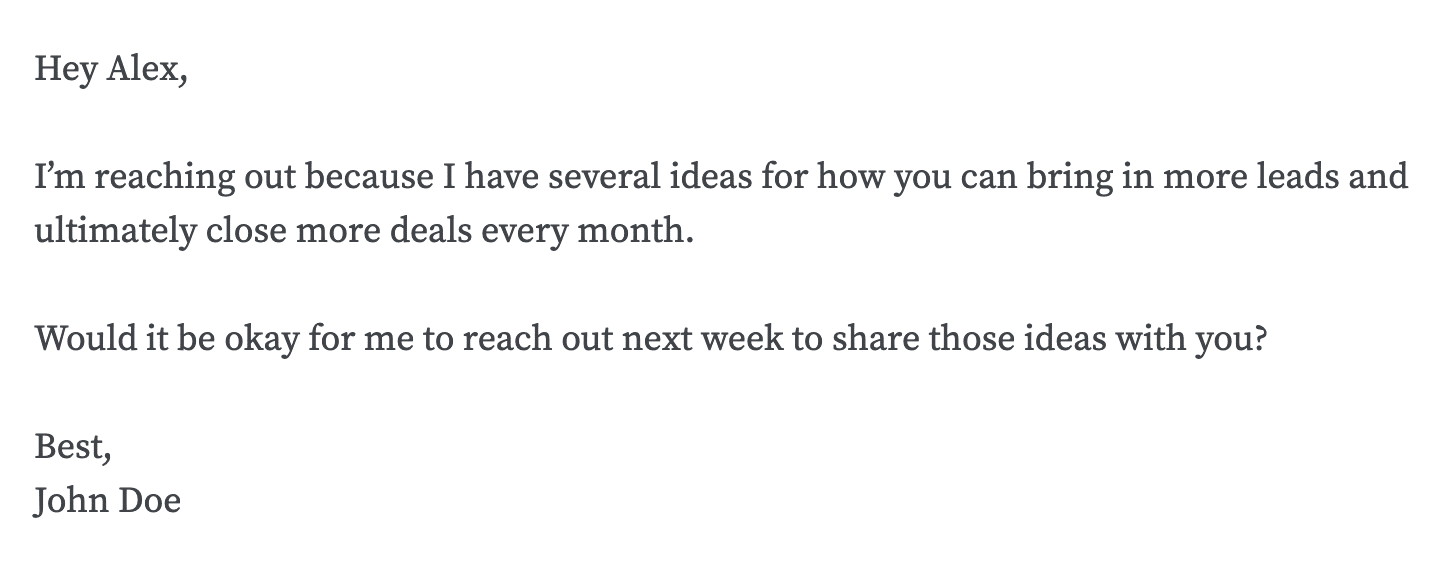
Image Source: mailshake
This example speaks volumes in a few words. Pair it with an equally impactful subject line.
Why does it work?
- It offers a solution without directly pitching a product or service.
- It ends with an engaging question that almost works as a CTA.
- It’s short and sweet.
A good promotional mail must not only promote the product or service you are launching. Sure, the primary focus must lie on your offering, but it must also let the lead know about other critical aspects of your brand like after-sales support or customer service. So, crisply talk about how you plan to support the customer once they shop from you.
3. New Product Announcement Email
While the previous template is all about indirectly promoting yourself, this product launch sample is to announce a new offering altogether. Here, rather than selling your offering, introduce its features.
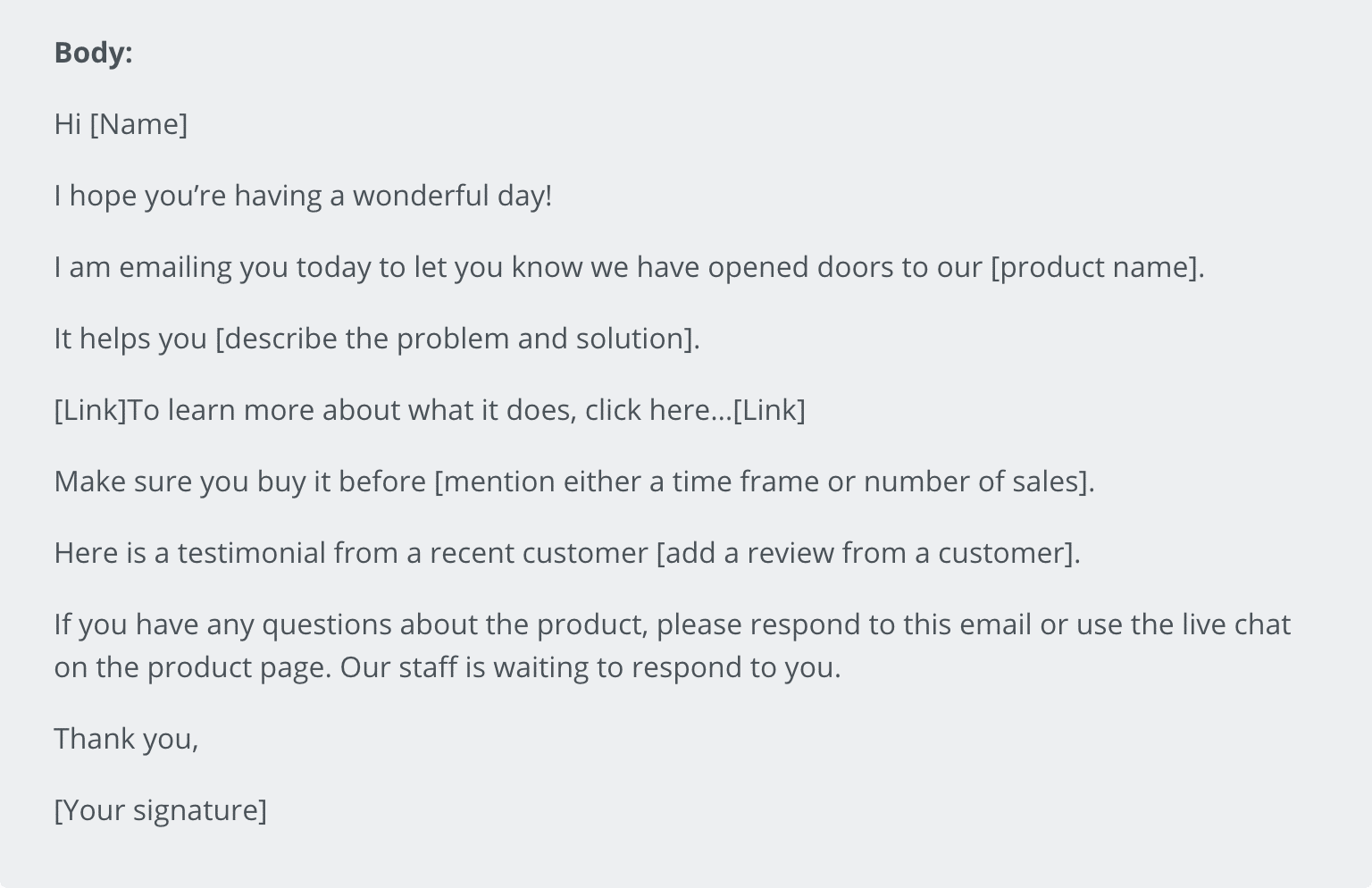
Image Source: Sumo
This email concisely tells your prospects all they need to know about your new offering.
Why does it work?
- It is crisp, informative, and personalised.
- It talks not about the product but how the launch specifically helps customers.
- It offers proof that your offering works through a testimonial.
Apart from announcing the launch of a new product, this template also informs the reader about its customer service efforts undertaken through “live chat”.
4. Informational Email
Do you have valuable information that can help your clientele? If yes, let them know through an informational email. Informational emails can contain tips, tutorials, gated content, or product guides. You can also share case studies and blogs to address their need gaps.
An effective way to begin informational emails is by telling prospects why you are sending them an email at all. Sending a random piece of information with no context will not help you achieve the desired outcome.
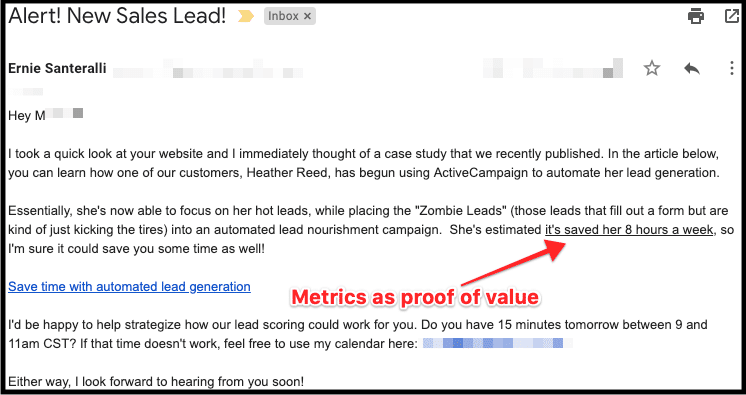
Image Source: ActiveCampaign
The very beginning of this email establishes a purpose and offers relevant context, so the reader knows exactly what they are being told and why it is important.
Why does it work?
- It offers personalisation. The writer of this email has certainly leveraged data to figure out why only a particular case study is relevant for their client.
- It grabs attention with its crisp and to-the-point conversational tone.
- The length of the email falls within the optimal range of between 50 and 125 words.
5. Upsell Email
Why upsell, especially in B2B? Repeat customers are known to spend more than first-time buyers. This is why writing an upsell email is critical to boost repeat business. Remember, repeat customers can form the bulk of your loyal client base.
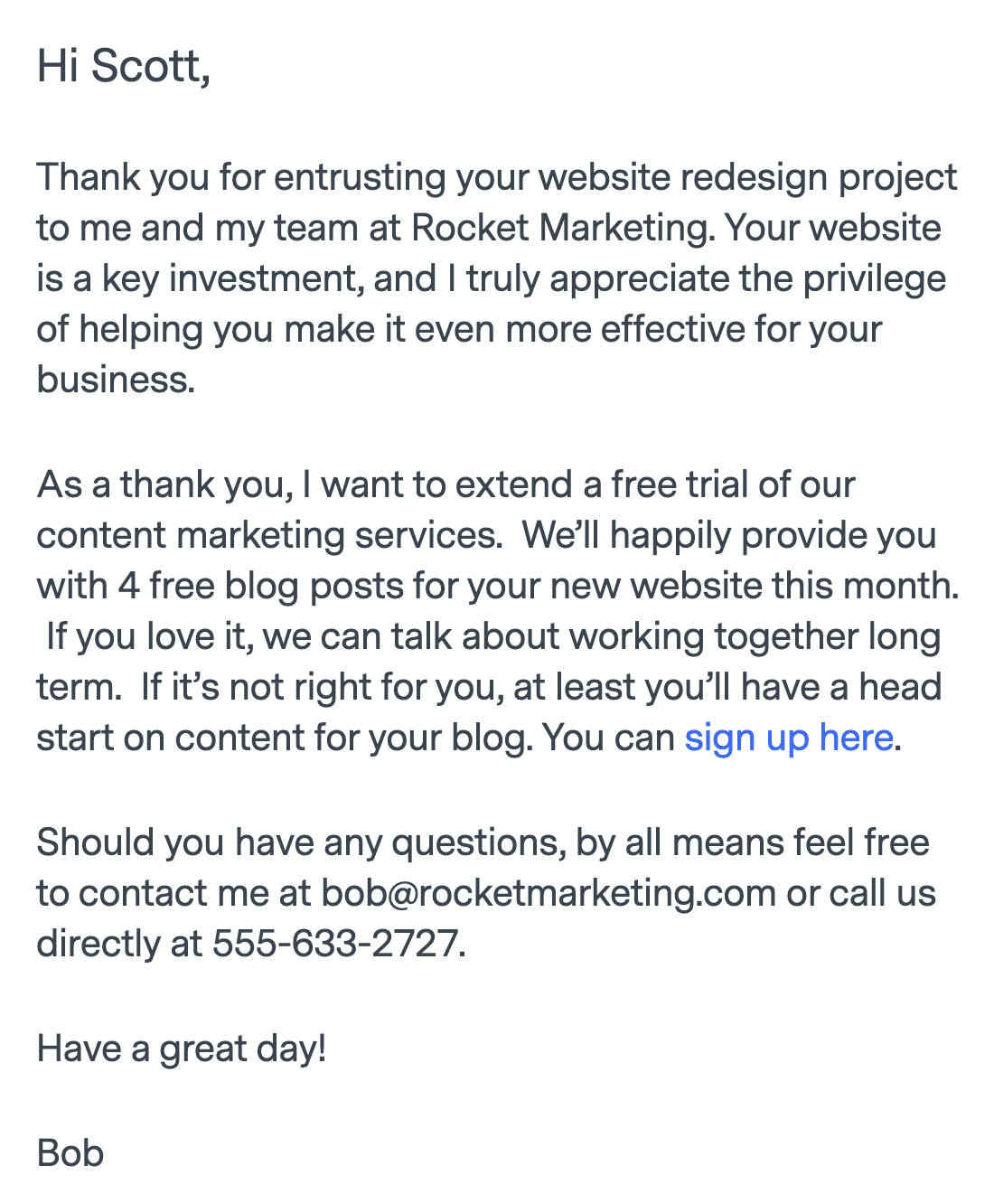
Image Source: Benchmark One
This upsell email is a classic example of a win-win for both the seller and their client. Here, Scott has a great way of publishing fresh content each month, and your brand has potentially opened a new revenue stream.
Why does it work?
- It genuinely delivers value to the client. You are offering help to get them started with content marketing.
- It does not directly pitch or promote your blog pieces; instead, it offers proof of their quality before having the client pay for them.
- The entire tone is one of gratitude and not of upselling.
While upselling through an email, don’t forget to insert your contact details as shown in this template. Doing so, tells the prospect that you are available for them on a more direct line as opposed to an 1800-something number.
6. Referral Email
Sure, referral emails get you more business. But the story doesn’t end there. This set of emails are also a great way to reward your loyal customers, and nurture qualified leads. Furthermore, referral emails allow prospects to learn your brand’s story and improve your overall image and reputation.
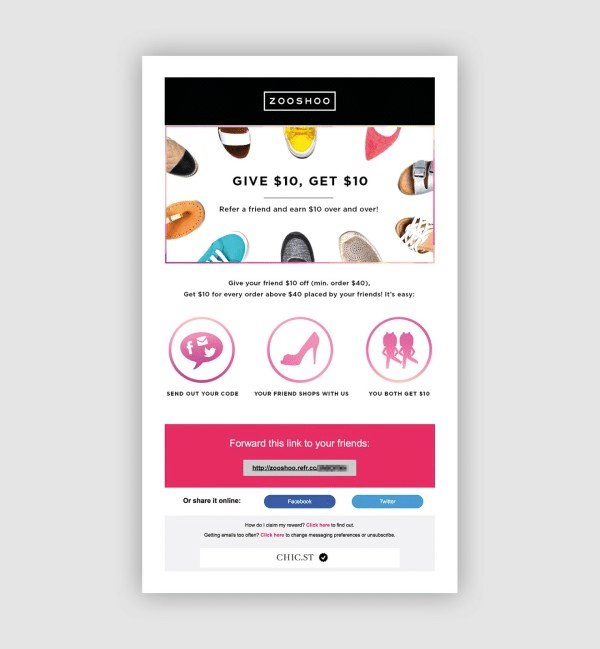
Image Source: Campaign Monitor
Zooshoo’s referral email keeps things to the point with their simple referral message. Their no-nonsense approach comes with effective CTAs that tell a prospect what to do next and who to reach out to in case they have doubts.
Why does it work?
- Low on content, high on money value.
- Loyal customers get a reward without making a purchase.
- Zooshoo’s crystal clear CTAs instil a sense of urgency.
7. Survey/ Feedback Email
If you want to win repeat business, you must ensure a steady stream of customer feedback and surveys.
But most customers are busy, which is why requesting them to fill out a lengthy feedback or survey form or write an email in response to yours doesn’t always work.
Allow us to help you! Refer to the feedback request email template below, for spiking your response rate. Also, do not attach a heavy or tedious survey form along with this email. The ideal number of questions in one survey should not exceed five to eight.

Image Source: Sumo
See how to the point this feedback template is. It tells the reader of your intent and doesn’t take more than a few seconds to read from start to end.
Why does it work?
- It shares a feedback form link embedded within the body. Stay far away from drafting emails that require readers to download attachments.
- The template mentions how long (five minutes) it will take for the prospect to fill out the feedback form. Always offer a time frame.
- It doesn’t beat around the bush or try to deliver a pitch. This sample is genuinely about collecting feedback.
8. Winback Email
Are you experiencing high customer churn rates? A solution is a winback email for re-engaging prospects and customers that have been inactive.
Image Source: ActiveCampaign
This winback template reminds customers of why they became customers in the first place with the help of a simple yet creative animated GIF.
Why does it work?
- This template is easy on the eye and carries a direct message.
- The CTA requests rather than demands to come back on board.
9. Customer Appreciation Email
You don’t need to wait for a special occasion or festival to engage customers with appreciative emails. Express gratitude when you hit a milestone as much as when they touch one. Sending out appreciation emails establishes a personal connection with your subscribers.
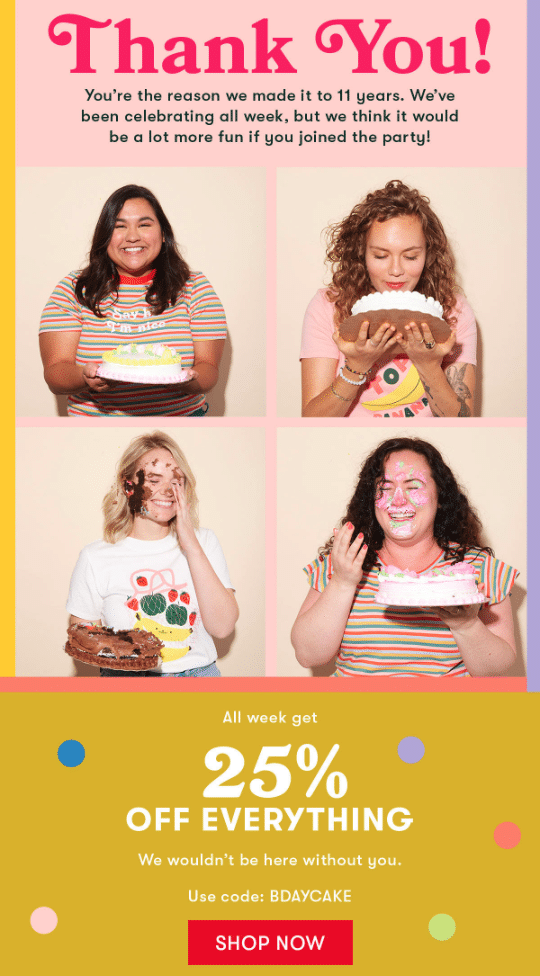
Image Source: Sleeknote
This email template not only puts a smile on your face, but also offers gratitude with a pleasant surprise in the form of a discount.
Why does it work?
- Even though the brand is celebrating its 11th anniversary, it still directs the spotlight on the customers.
- The appreciation email does not ask for anything in return. No personal or contact information and no referral drive. This shows a genuine effort to simply thank their customers.
- The wording is minimal, and the CTA is unambiguous.
10. Progress Email
As the name suggests, a progress email is written to share an update about an ongoing project with your client base. The length of this email entirely depends on how much content you wish to share.
Here is a sample template for a progress email.
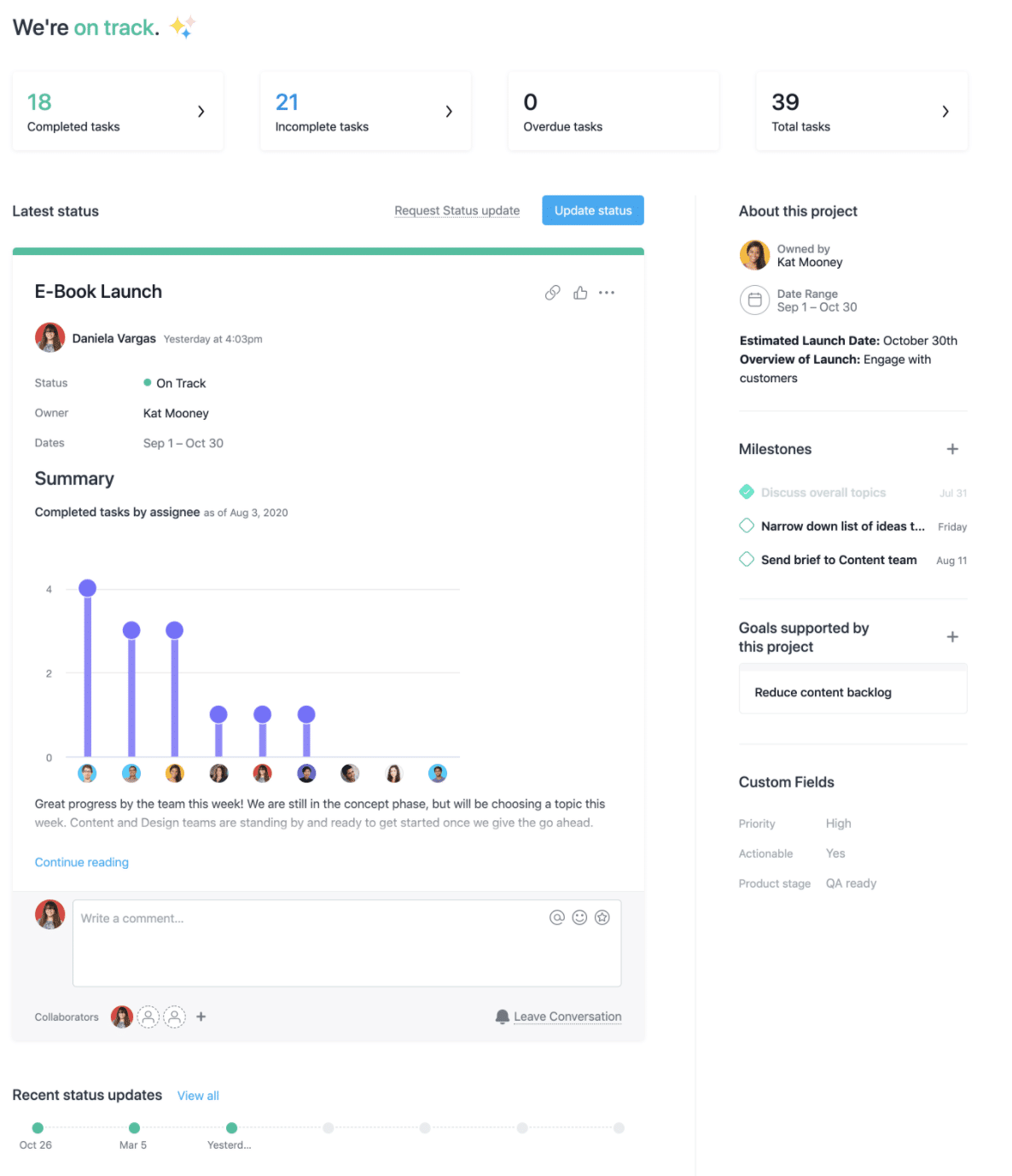
Image Source: Asana
Your status update need not look exactly like this, but it must contain important updates, much like what is shown here. This email talks about the launch of an e-book, and right in the beginning, tells the reader that things are on track.
Why does it work?
- This template is light on content and high on imagery, and is also interactive.
- It displays the total number of tasks assigned, completed, and pending all in one snapshot.
- It also allows the viewer to tag and leave a comment.
A personalised progress email update tells your customer you care about their well-being. It is also a great exercise in customer support.
11. Newsletter Email
A very effective email marketing medium, newsletters keep your customers updated on the latest news about your brand’s offerings. Newsletters are often used for announcing product launches, doling out personalised discount coupons, declaring flash sales, collecting feedback, and much more.
Here is a sample newsletter to inspire you.
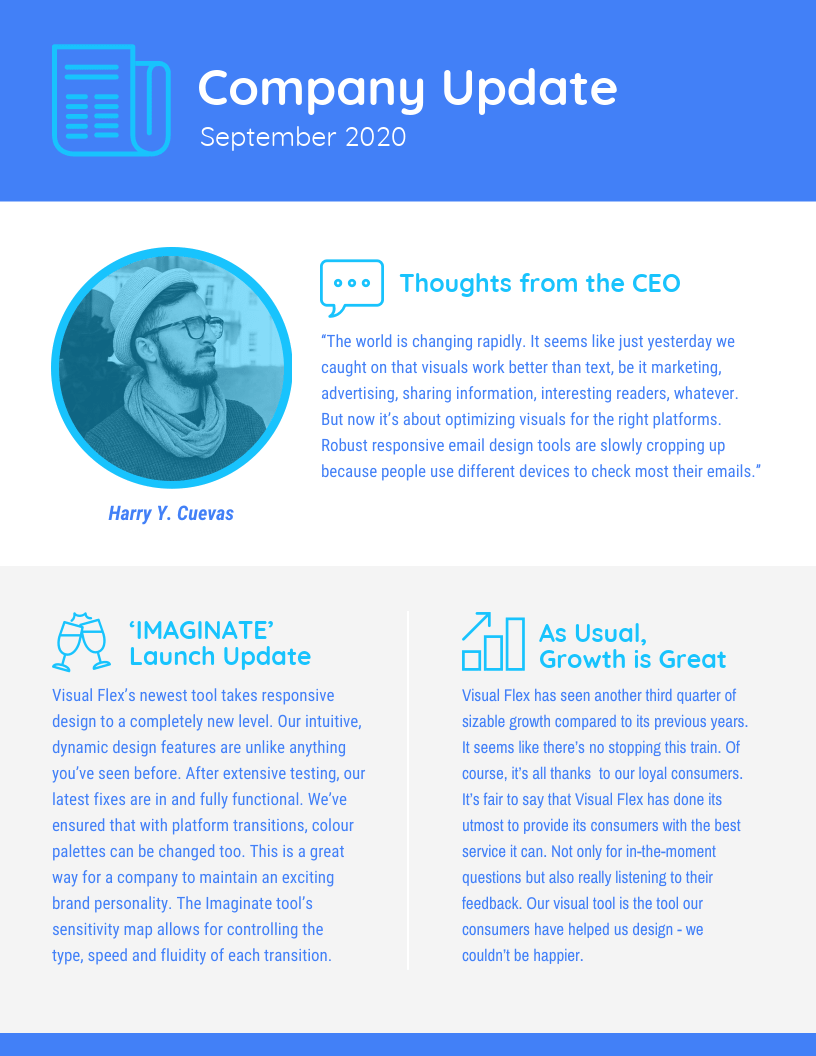
Image Source: VENNGAGE
This newsletter updates staff, investors, and clients alike. The design is also easy on the eye with a uniform colour scheme. You could also choose an animated GIF in your newsletter, provided it doesn’t take attention away from the main message.
Why does it work?
- It offers all necessary details without beating around the bush.
- The layout is simple, and the font is legible and the right size.
- It carries informative sub-heads in a conversational tone, making the entire newsletter easy to glance through.
Best Practices for Writing Marketing Emails
As shown in the examples above, every email serves a different purpose. However, there are some best practices you can adopt before planning your next email drive:
Concentrate on Content, Not Length
Always value your prospect’s time and give them only a sliver to read. Readers will likely consider long emails over-stuffed with buzzwords as nothing but fluff. So, keep the content body over 25 but under 200 words.
Don’t Scream Sales
Convey value without pushing your product down your customer’s throat. Do not overburden the reader with an overbearing sales pitch. That said, do introduce what your offering can do more so than what it is.
Don’t Craft Vague Subject Lines
Nothing brings down the email open rate quite like a lousy and ambiguous subject line. Many leads might even report your email communication as spam if they see a poorly drafted email subject. Remember, there is a fine line between attention-grabbing and click-bait subject lines. Choose the former.
First Mail to Prospect Must Always Contain an Introduction
You will be surprised how many brands get started with pitching without adequately introducing themselves. In-your-face email marketing never works, so tell them a bit about your brand in an authentic and heartfelt manner. Just a couple of lines will also do.
Know Where Your Potentials Are in their Buying Journey
Figure out those potential customers that are most likely to buy. Draft your email accordingly and prioritise reaching out to them. Not much point selling to a customer who has exhausted their annual budget for procuring the kind of products you sell.
Sure, you can reach out to your target audience even if they are not in a position to buy at the time or haven’t decided on a solution, but these should not be your priority.
Let Them Know You Are There for Them
Today, selling a great product is simply not enough. You must ensure your prospects know that they will receive exceptional customer service or support after they complete the purchase. So, make sure all your emails carry a hassle-free way for them to reach out to you.
Offer Solutions that Directly Address Pain Points
Prospects don’t really want to read a sales email. They want you to help them address their need gaps and pain points. So, write an email that does not talk about how great your product is but how it can help your customers.
Highlight Your Offering’s USP
If you have a product that nobody else offers, mention its unique selling proposition (USP) with proper proof in the email.
Your Turn
It’s no secret that the right email and automated email marketing software will take you places! Keeping in mind the right way to go about it, as shown in the templates above, it‘s now time for you to get started with your campaign.
Updated Jan 16, 2023
